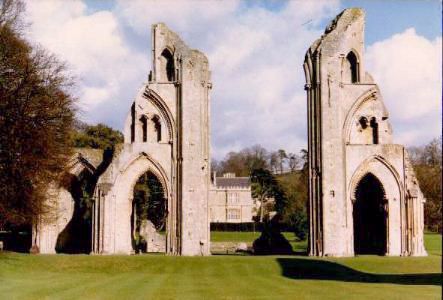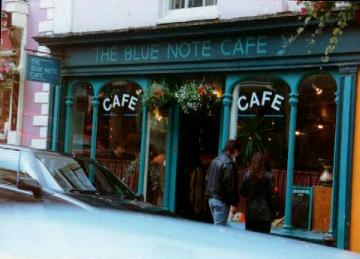

Picture by Mick McKenna
VIRTUAL TOUR OF GLASTONBURY, U.K.
THE TOR
Visible for miles around, this is probably Glastonbury's most famous land-mark. Sacred to Pagans and Christians alike, it has been a site of worship since time immemorial. The tower you can see on the top is all that is left of the church (dedicated to Michael, the prince of the high places) which once stood on the summit. The horizontal lines sculpted into the side of the Tor are a different matter. Some say they are the remnants of medieval strip linchets, used to cultivate grapes. However, if you view the Tor from the air or afar, there is a pattern similar to the sacred circular labyrinths that go back thousands of years. The local Goddess devotees say therefore, that this hill was once given over to Her worship. Some say that if you follow the pattern in the right way, making the correct incantations, on the right day and with a pure heart, you will either:-
In addition to all this, the Tor is at the
crossroads of the great Mary and Michael ley lines and in the centre of very
powerful earth energies. I know that even on the stillest, hottest day, there
is always a breeze on the top. When the air is clear there are also wonderful
panoramic views of Wells, Cheddar (where the cheese comes from), the moors,
Street, the Mendip hills, the Brendon hills (that lead up to Dartmoor), Wearyall
Hill, Brent Knoll and even the blue line of the hills of Wales in the far
distance.
THE ABBEY

Picture by Mick McKenna
Established at least as long ago as A.D. 200, when
there was a modest building of wattle and daub, the most ancient dedication to
the Blessed Virgin Mary north of the Alps for over a thousand years. During
the Celtic period, the saints who are said to have visited sound like an honour
role. Patrick, Brigid (Bride) and David of Wales, who is supposed to have
helped start construction on the later wooden church. At that time, just like
Iona, important local chieftans were buried in the churchyard outside. One such
6th century burial between two pillars contained a boat and two skeletons - a
tall man and a woman with golden hair. The lead cross on top of the makeshift
coffin (now lost somewhere in Wells) bore the inscription in Latin : "Here
lies King Arthur, the once and future king." When the monks realised
exactly whom they had uncovered, the two bodies were re-interred, with much pomp
and ceremony, in the presence of the King and Queen to a marble tomb right in
front of the High Altar.
St. Dunstan (a local lad) became abbot in
986 and remodeled the Abbey along Benedictine lines. At about that time there
was a great fire and the wooden church on top of 'the old church' was burnt
down. Undeterred, Dunstan initiated rebuilding in stone. When he had a free
moment, he went off and crowned Edgar the first King of all England in Bath
Abbey. Glastonbury grew and flourished. We had our own Abbot bishop and
pilgrims came from far and wide to see the largest chuch building in England,
see the Holy Thorn and hear the legend that Joseph of Arimathea himself founded
the Abbey, his staff taking root and flowering being a sign that this was a good
place to stop. Descendants of the Holy Thorn still grow in Glastonbury,
blossoming twice a year at Easter and Christmas. Cuttings are taken every year
and sent as a loyal tribute to their Majesties the Queen and the Queen Mother
and they adorn their breakfast tables every Christmas morning.
Why
is the Abbey clearly in ruins? That was the fault of Henry 8th and the trouble
he had getting his divorce. Because Glastonbury was large, powerful, rich and
well-loved, the blow fell hard here. It is told that a few of the most holy
relics were sprited away, including the Holy Grail. Despite its bloody end, it
is a place of peace, tranquillity and beauty to this day.
THE BLUE NOTE CAFE

Picture by Philippa Chapman
I had to put this one in for all you ATHers and
Highlander fans. I wasn't entirely sure you'd believe me unless you'd seen the
place with your own eyes. They serve tea, coffee, light meals and a small
selection of alcohol, but, unfortunately, not live music. However the walls
are adorned with huge black and white photos of blues and jazz legends (largely
deceased), so you can imagine the music. If you're ever in town, we can meet
there for a cup of coffee or two and have a chat.
THE TWO SPRINGS
Celtic folk may shiver when I tell you that the two springs
in Glastonbury are white and red. The white one comes to air inside a
cafe called the White Spring and runs in a channel down the middle of the floor.
The water is clear, cold and very fresh. You can go in at any time the cafe is
open and drink as much as you like without charge. Some people bring barrels
and take supplies home with them. Just across the road is the red spring,
coloured by the iron deposit in it. So the taste is metallic, but again very
good for you. Prince Charles had a sample last time he passed through.
According to legend, the redness in the water is due to the fact that the spring
rises near or in the buried Holy Grail. Be that as it may, the beautiful and
tranquil gardens that surround the red spring are well worth a visit.
THE EXCALIBUR CAFE
This establishment is situated just over half way up the
High Street, on the right as you travel up-hill. Open for breakfast through to
light lunches and containing a wealth of quasi-medieval Arthurian objects.
These incluse a list of all the knights in their places around the fabled round
table, a couple of brass rubbings, a facsimile of the Declaration of Arbroath
(I don't know what that's doing in Glastonbury) and a blunt 'copy' of
Excalibur on the rear wall. The sword is apparently modelled on the one in the
film, Excalibur.
THE ROYAL MEDIEVAL ALMSHOUSES
Painting by Gunvor Stallybrass
This small complex was founded in the 14th
century to care for warriors returning from the Crusades with leprosy and other
exotic unknown diseases. Originally, there was a barn structure attached to the
small chapel and the monks catered for 13 men at a time. In the days before
real hospitals, hospices and welfare, this was a vital service. After the
dissolution of the monastery, the barn was knocked down and individual
almshouses were built. Each man had his own fireplace, bed-loft and tiny living
area. Near the chapel was a communal kitchen and at the far end, the men had a
washroom and a modest vegetable garden. The almshouses are now the property of
English Heritage and used Monday to Friday by the ecumenical and Celtic
Christian 'Quest Community', along with the chapel. At 12 o'clock each day
(except Sunday) there is a short service in the chapel open to all, regardless
of faith. On Wednesdays there is often a led meditation with music and on
Saturdays, a silent meditation. Between early morning and dusk the chapel and
garden are available for personal 'space' and contemplation. Members of the
Community are often at hand if you wish to talk, or will leave you to explore
the quiet room, craft room, library and reception room in the almshouses by
yourself. At the East end of the chapel you will find a new book shop, run
mostly by volunteers. Above the shop is a self-catering pilgrim maisonette for
anyone who would like to have a contemplative and spiritual holiday in
Glastonbury. If you arrive at the right time of day, you may find yourself
included in a shared lunch or an afternoon discussion session.
There's a lot more to Glastonbury - the Rural life museum,
the churches, the restaurants, the pubs, Queen Anne's maces and our local
population of long haired gents (and ladies) who sometimes get close to looking
like the extras in flashback and modern sequences of Highlander, including one
or two who seem to be attempting the Four Horsemen part deux. We even have a
resident Scottish laddie from Ayrshire who regularly busks, playing his bagpipes
outside the main church. I don't need to move, do I?!!?
It was all of this that led me to write my soon to be published Highlander
fanfic called ISLE OF AVALON.

| E-mail me at: philippa@dapc.globalnet.co.uk |